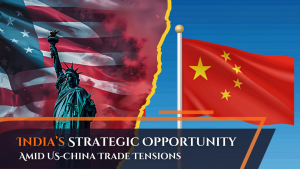Font size:
Print
Aero India 2025
Context:
Raksha Mantri Shri Rajnath Singh held bilateral meetings with the Minister for Defence and Veteran Affairs, Republic of Fiji, Mr. Pio Tikoduadua, and the Minister of Defence and Veteran Affairs, South Sudan, Lt. Gen. Chol Thon J Balok in Bengaluru, Karnataka, on February 9, 2025.
Key Highlights
- Agreement to institutionalise the India-Fiji Joint Working Group on Defence Cooperation as per the MoU signed in 2017.
- Decided to strengthen Maritime Domain Awareness for:
- Maritime safety and security
- Exclusive Economic Zone (EEZ) protection
- Naval capacity building
- Training cooperation for UN peacekeepers and defence civilians
- South Sudan appreciated India’s contributions to the United Nations Mission in South Sudan (UNMISS).
India’s Deterrence Strategy
- India has successfully demonstrated the three pillars of effective deterrence: capability, credibility, and communication in its strategic posture towards China over the past decade.
- This strategy has been supported through defence diplomacy with key partners in South Asia, Southeast Asia, and the broader Indo-Pacific region.
Key Aspects of India’s Defence Diplomacy
- India engaged in joint military exercises, officer exchanges, high-level visits, and bilateral defence agreements.
- Some notable agreements include:
- India-U.S. Defence Partnership under the Major Defence Partner status.
- India-Russia Military Cooperation involving technology transfer and defence procurements.
- India-France Strategic Dialogue, focusing on Indo-Pacific security.
- India-Japan Defence Collaboration, strengthening naval security and infrastructure development.
- These efforts have reinforced India’s standing as a formidable power in the Eastern Hemisphere.
- India also actively monitors the Exclusive Economic Zones (EEZs) of partner nations and provides naval training and capacity-building programs for smaller nations.
Malabar Naval Exercises
- In 2015, India, the US, and Japan agreed to make Japan a permanent participant in the Malabar exercises, which expanded to include Australia in 2020, consolidating the Quad’s naval cooperation.
- The exercises have grown in scope, covering carrier-strike operations, anti-submarine warfare, and maritime reconnaissance.
- These exercises serve as a primary platform for naval diplomacy and deterrence against China. Conducted across key locations such as the Bay of Bengal, Arabian Sea, Philippine Sea, East China Sea, Japan, and the South Pacific.
- The Chinese government has criticised these exercises and India’s role in scrutinising Chinese vessels.
Military Exercises and Training Programs
- India conducts numerous joint military exercises to enhance operational coordination and interoperability with partner nations. Some key exercises include:
- Malabar Exercise (India, U.S., Japan, Australia) – Naval cooperation
- Varuna (India-France) – Maritime security
- Hand-in-Hand (India-China) – Counter-terrorism training
- Yudh Abhyas (India-U.S.) – Army warfare training
- Additionally, India provides training to foreign defence personnel through institutions such as the National Defence Academy (NDA) and the Defence Services Staff College (DSSC).
Strengthening Maritime Security
- Freedom of navigation initiatives
- Collaborations with Quad nations (India, U.S., Japan, Australia)
- Indian Ocean Rim Association (IORA) engagements
- Mission SAGAR (Security and Growth for All in the Region), aimed at assisting Indian Ocean nations
Defence Diplomacy with Southeast Asia
- India’s strategic interests in the South China Sea and the Western Pacific have led to strengthened ties with Southeast Asian states like Singapore, Vietnam, and the Philippines.
- Singapore signed a Defence Cooperation Agreement in 2015, followed by a naval cooperation agreement in 2017. Additional pacts on Submarine Rescue Support, cybersecurity, and disaster relief enhance cooperation.
- Vietnam elevated its military ties with India to a Comprehensive Strategic Partnership in 2016. India supports Vietnam on global platforms and increases naval deployments in the South China Sea. Material support includes:
- US$100 million credit line to procure 12 patrol vessels from an Indian shipyard.
- INS Kirpan missile corvette was gifted to the Vietnamese Navy in 2023.
- Potential BrahMos missile sale under discussion.
- Vietnam remains a crucial partner in India’s Act East Policy and Indo-Pacific strategy.
- The Philippines has become an important partner, with India selling three BrahMos supersonic cruise missiles to the Philippines Marine Corps—expanded cooperation in cybersecurity, intelligence sharing, and joint training.
India’s Growing Defence Trade and Strategic Influence
- India has increasingly voiced opposition to China’s expansionist policies and advocated for a rules-based order in the Indo-Pacific.
- India’s defence trade is expected to grow, with Indian defence platforms gaining recognition for their quality.
- India is emerging as a major supplier of defence goods, particularly in countries near China, reshaping long-term strategic partnerships.



